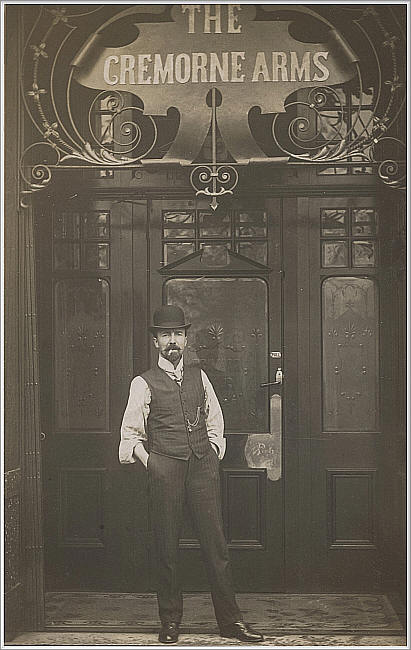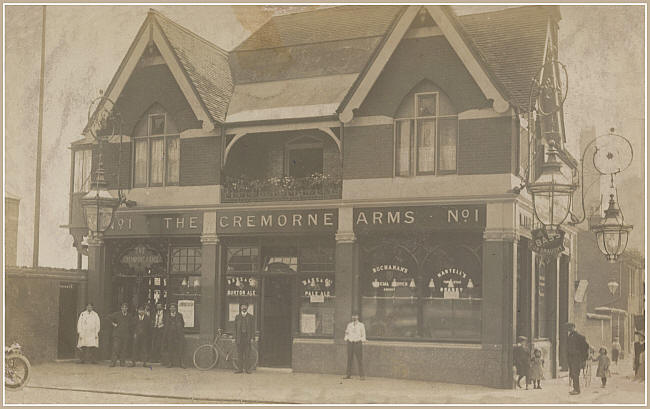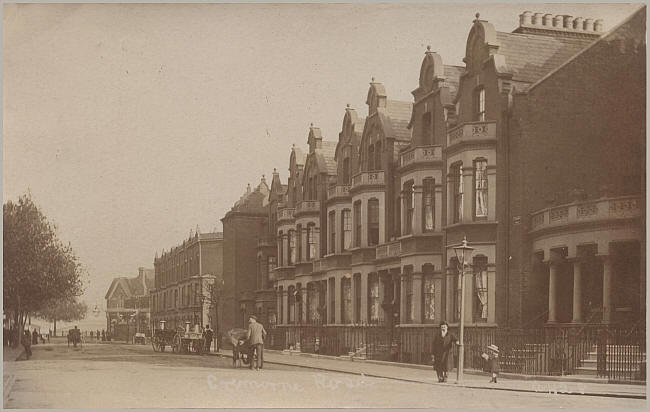

Search my many thousands of pubs and London history
Chelsea Pub history index
In Cremorne road in 1869 and 1874; the 1851 census and 1856 directory refer to Cremorne House; and in 1861 census listed as the Cremorne Tap. There is a building on the 1865 OS map by the embankment entrance of Cremorne Gardens. Although it is not marked as a pub in 1865, the position and size matches that of the Cremorne Arms in all later maps and so I am guessing that this building is what became the Cremorne Arms. The pleasure gardens closed in 1877 and the later Lots, Cremorne and other Roads were constructed. *
Historical London public houses, Taverns, Inns, Beer Houses and Hotels.

Cremorne Arms, 1 Lots Road, Chelsea, London - circa 1900s
It seems likely to me that the the landlord is John Gardiner Banfield
Kindly provided by Mal McCauley

Cremorne Arms, 1 Lots Road, Chelsea, London - circa 1900s
Kindly provided by Mal McCauley

Cremorne Road, Chelsea, London - circa 1900s
Kindly provided by Mal McCauley
Residents at this address.
Chelsea Farm was sold to Richard, Viscount Powerscourt (d. 1751). He was succeeded by the Countess-Dowager of Exeter, widow of Brownlow, the eighth earl. Then came Sir Richard Lyttleton (d. 1770), the friend of the poet Shenstone, (d. 1777).
Thomas Dawson, Baron Dartrey (created Viscount Cremorne in 1785) was the next occupant. He enlarged the house, and made many alterations in it, from the designs of James Wyatt, an architect of the pseudo-classic taste. Chelsea Farm, afterwards known as Cremorne House or Villa, had little or no architectural merit. Faulkner's and other views represent a building without any claim to beauty, but the grounds about it were fine and richly wooded. They are mentioned by Hassell in his 'Excursions on the Thames' (1823):
Cremorne House may be regarded as one of the last of the great houses that gave dignity to Chelsea, and its park one of the last spreads of fine home scenery' that beautified it.
Lady Cremorne is celebrated in the 'Percy Anecdotes' as the best mistress of a household that ever lived, and there are many references to her goodness and gentle nature in Mrs. Carter's memoirs. This lady, the translator of Epictetus, addressed several short poems to her friend and her children.
Lady Cremorne enjoyed the particular friendship of Queen Charlotte, who often visited her at Chelsea.
Bryan says that Lady Cremorne resided at Chelsea the greater part of the year, and kept a large establishment. She was greatly liked in the parish, as she gave her household special orders to patronize the local tradesmen as far as was practicable. Every year, too, she gave an entertainment to all the school-children in the parish, and these entertainments were repeated whenever Queen Charlotte visited Cremorne House.
Viscount Cremorne died in 1813, leaving no surviving issue either by his first or second wife, and his titles of Baron Dartrey and Viscount Cremorne became extinct, but his other title, Baron Cremorne (created 1797) devolved on his great-nephew. His 'Villa of Chelsea Farm' he bequeathed absolutely to his wife.
Philadelphia Hannah, Lady Cremorne, was the great-grand-daughter of William Penn, founder of the State of Pennsylvania, and was born in its splendid capital, after which she was named. When she died in 1825, she bequeathed her estate in Chelsea to her cousin, Granville Penn. He resided there for some years, and put it up for sale in 1826-27 and 28, but it was bought in on each occasion.
A large but not very notable collection of paintings at Cremorne House was sold by auction in 1827. Faulkner gives the complete list, in which we find views of Chelsea Farm and Battersea Bridge by De Cort of Antwerp, with others by the same hand, and important stained-glass window by Jarvis, examples by Teniers, and Copley's fine copy of Correggio's masterpiece, The Communion of St. Jerome,' bought by the painter's nephew, the celebrated Lord Lyndhurst.
Cremorne House was at length purchased by Charles Random de Bérenger, Baron de Beaufain, who established here a National Club' for the cultivation of 'various skilful and manly exercises, being a British arena for such pursuits.' It was named the Stadium.
In the New Sporting Magazine for 1831 we read:
'The Club is to be divided into three branches. No. 1. The department for cultivating perfection in shooting generally. No. 2. For aquatic pursuits, sailing, rowing, swimming, fishing, waterfowl shooting and bathing. No. 3. The department for general purposes, and for investigating improvements. Its care, says the prospectus, will be to promote, by a variety of means, all matters connected with the manly, skilful, or useful exercises, not already set forth, such as fencing, archery, riding, driving, skating, coursing, hunting and racing.'
In a letter to the Earl of Lichfield, March 3, 1838, the Baron, in asking for Government support, states that the Stadium had 'engrossed alike his attention and his means for the last eight years.' This forerunner of the Hurlingham and Ranelagh Clubs was still flourishing in 1841; in a handbook to Chelsea published in that year we read that 'galas are likewise given here on a most magnificent scale, which are patronized by most of the nobility.' The name of this club has been perpetuated in one of the recently-built streets, Stadium Street.
In 1845 the estate was opened as Cremorne Gardens. These never acquired the aristocratic reputation enjoyed by Ranelagh Gardens in the previous century, but after some years of disreputable existence, became such a nuisance to the neighbourhood that they were closed on October 4, 1877. The grounds are now almost entirely built over, and nothing remains to recall the varied associations of the spot but some grottoes and plaster figures in Messrs. Wimsett's nursery, and the large gates at Mr. Bowden's brewery, near Stanley Bridge. Dartrey Road and Cremorne Road, however, preserve the name of the best-remembered owner of the estate.
Pigots 1836 Taverns, Hotels, Inns and Coffee House, Stadium, or National Arena; Hotel, Pleasure grounds &c, Cremorne House, Kings road, Chelsea - Baron de berenger, proprietor
Morning Advertiser. 19 October 1837
Theatrical Licences to places of Public Entertainment within the County of Middlesex, to be applied for this day.
Pursuant to the Act of the 26th George II to grant licences for "public music, dancing, or other public entertainments of the like kind.
The Stadium, Cremorne House, Chelsea - Charles Randon de Berenger
1851/Henry Stallard/Victualler/34/Islington, Middlesex/Census
1851/Elizabeth Stallard/Wife/29/St Giles, Middlesex/Census
1851/Elizabeth Stallard/Daughter/6/Lee, Kent/Census
1851/Harriet Stallard/Daughter/4/Lee, Kent/Census
1851/Matilda Stallard/Daughter/1/Chelsea, Middlesex/Census
1851/Sarah Turner/Barmaid/24/Chelsea, Middlesex/Census
1851/Ann Day/House Servant/29/Ireland/Census
1856/T B Simpson/Cremorne House, Kings Road west/../../Post Office Directory
1861/Elizabeth Brighton/Publican, Widow/44/Marylebone, Middlesex/Census
1861/Elizabeth B Brighton/Daughter/12/St Pancras, Middlesex/Census
1861/James Brighton/Son/5/St George Bloomsbury, Middlesex/Census
1861/John Harding/Potman/57/Somerset/Census
1869/Edward Tyrrel Smith/../../../Post Office Directory
1874/John Baum/../../../LV Directory
1881/William J Baker/Licensed Victualler, Widow/49/Blackfriers,
Middlesex/Census
1881/Harriet Scarfe/Housekeeper/39/St Andrews, Norfolk/Census
1881/Harriet Scarfe/Daughter To Housekeeper, Servant/14/St Saviours
Southwark/Census
1881/Harriet Creak/Mother To Housekeeper, Visitor For The Night/65/St Giles,
Norfolk,/Census
1881/George Holdsworth/Postman Out Of Business/25/Lambeth, Surrey/Census
1882/William James Baker/../../../Post Office Directory
1884/William J Baker/../../../Post Office Directory
1899/John Gardiner Banfield/../../../Post Office Directory
1901/John G Banfield/Licensed Victualler/31/Great Yarmouth/Census
1901/Rosina J Banfield/Wife/31/Ashford, Kent/Census
1901/Victoria H Banfield/Daughter/3/Southwark, London/Census
1901/John R Banfield/Son/1/Chelsea, London/Census
1901/Alfred G Jackman/Barman/20/Great Yarmouth/Census
1901/Emily J Wright/Barmaid/19/Longford, Bucks/Census
1901/Agnes M Lacy/Barmaid/23/Clerkenwell, London/Census
1901/Fanny M Smith/Domestic Servant/21/Camberwell, London/Census
1911/John Gardiner Banfield/Licensed Victualler/41/Great Yarmouth/Census
1911/Rosina Jane Banfield/Wife/45/Ashford, Kent/Census
1911/Victoria Hope Banfield/Daughter/13/Southwark, London/Census
1911/John Roberts Banfield/Son/11/Chelsea, London/Census
1911/Frank Allan Banfield/Son/5/Chelsea, London/Census
1911/Stanley Harold Blow/Barman/20/Hoxton, London/Census
1911/Winifred Amy Saunders/Barmaid/27/Wandsworth, London/Census
1911/Violet Mabel Millward/Barmaid/24/Hackney, London/Census
1911/Nellie Butler/Barmaid/20/Hackney, London/Census
1911/Ethel Minnie Turner/Cook/25/Bedford/Census
1915/John Gardiner Banfield/../../../Post Office Directory
1921/John Smith/../../../Post Office Directory
In 1921 census at 1 Lots Road, Chelsea
John Alfred Smith, Publican, Cremorne Arms, 1 Lotts Road, Chelsea, aged 47 years, and born in Peckham, London
Minnie Maud Smith, Wife, House Keeper, aged 44 years 8 months, and born in Camberwell, London
Aubrey Alfred Smith, Son, Engineer, 1 Lotts Rd, Chelsea, aged 16 years 10 months, and born in Acton, London
Lilian Beatrice Huttley, Barmaid, Cremorne Arms, 1 Lotts Road, Chelsea, aged 20 years, and born in Highbury, London
1934/Sidney Edmund Moore/../../../Kellys Directory
1938/R V Goodhew Ltd/../../../Post Office Directory
* Provided by Mal McCauley